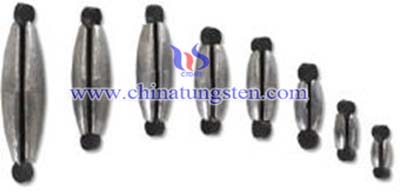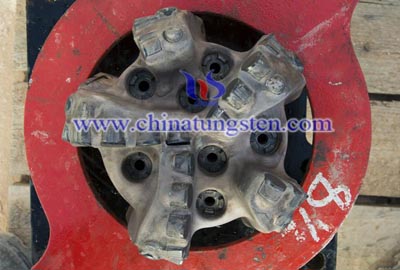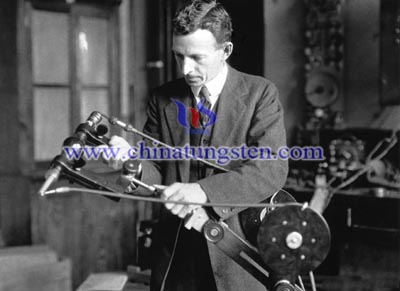The Processing of Tungsten Alloy
- Details
- Category: Tungsten Information
- Published on Wednesday, 03 September 2014 17:19
Tel.: 86 592 5129696; Fax: 86 592 5129797
Email: sales@chinatungsten.com
Tungsten & Molybdenum Information Bank: http://i.chinatungsten.com
Tungsten News & Tungsten Prices, 3G Version: http://3g.chinatungsten.com
Molybdenum News & Molybdenum Price: http://news.molybdenum.com.cn
Brief Introduction of W-Re Thermocouple
- Details
- Category: Tungsten Information
- Published on Wednesday, 03 September 2014 16:48
| W Re, (Positive) | W Re, (negative) | |||
| Element | Re | W | Re | W |
| Content,wt% | 3.00 | balance | 25.00 | balance |
Tel.: 86 592 5129696; Fax: 86 592 5129797
Email: sales@chinatungsten.com
Tungsten & Molybdenum Information Bank: http://i.chinatungsten.com
Tungsten News & Tungsten Prices, 3G Version: http://3g.chinatungsten.com
Molybdenum News & Molybdenum Price: http://news.molybdenum.com.cn
Brief Introduction of Tungsten Electrode
- Details
- Category: Tungsten Information
- Published on Wednesday, 03 September 2014 16:43
| Type | compositions | colors | |||
| added oxide% | substances | substances% | tungsten% | ||
| W | <0.20 | 99.8 | green | ||
| WT4 | 0.35--0.55 | THO2 | <0.20 | remaining | blue |
| WT10 | 0.8--1.20 | THO2 | <0.20 | remaining | yellow |
| WT20 | 1.70--2.20 | THO2 | <0.20 | remaining | red |
| WT30 | 2.80--3.20 | THO2 | <0.20 | remaining | violet |
| WT40 | 3.80--4.20 | THO2 | <0.20 | remaining | orange |
| WZ3 | 0.15--0.50 | ZrO2 | <0.20 | remaining | brown |
| WZ8 | 0.70--0.90 | ZrO2 | <0.20 | remaining | white |
| WL10 | 0.90--1.20 | LaO2 | <0.20 | remaining | black |
| WC20 | 1.80--2.20 | CeO2 | <0.20 | remaining | grey |
2. Specifications (mm)
| Diameter | Length |
| 1.0 | 150 175 |
| 1.6 | |
| 2.0 | |
| 2.4 | |
| 3.2 6.3 | |
| 4.0 8.0 | |
| 5.0 10.0 |
Tungsten Manufacturer & Supplier: Chinatungsten Online - http://www.chinatungsten.com
Tel.: 86 592 5129696; Fax: 86 592 5129797
Email: sales@chinatungsten.com
Tungsten & Molybdenum Information Bank: http://i.chinatungsten.com
Tungsten News & Tungsten Prices, 3G Version: http://3g.chinatungsten.com
Molybdenum News & Molybdenum Price: http://news.molybdenum.com.cn
Tungsten Rubber Core Fishing Sinkers
- Details
- Category: Tungsten Information
- Published on Wednesday, 03 September 2014 09:03
Tungsten rubber core fishing sinkers have a groove like a split shot and two tabs also called ears on each end of the sinker. Rubber core tungsten fishing sinkers resemble the oval and American football shape .The line is placed in the centre groove, and the tabs are for fixing the line in place by twisting the line in opposite directions, finally wrapping the line around the rubber core. If you want to release the line, just twist the two tabs in reverse. Rubber core fishing sinkers can quickly be added or removed and do not brake the line.
Rubber core fishing sinkers have many applications. The common applications is using a small 1/8 ounce version for live bait offerings, or adding a large sinker when trolling long-lines to help baits run at greater depths.
Lead is widely used as the materials for this type of tungsten fishing sinkers. However, there are more and more alternatives come out because of its toxic property. The environmental friendly materials tungsten alloys are more widely used. As the high density of tungsten alloy, tungsten alloy rubber core fishing sinkers are about 30 percent smaller than lead ones. So that it is delighting to achieve desired weight with a small volume.

Tungsten Alloy Manufacturer & Supplier: Chinatungsten Online - http://www.tungsten-alloy.com
Tel.: 86 592 5129696; Fax: 86 592 5129797
Email: sales@chinatungsten.com
Tungsten News & Tungsten Prices, 3G Version: http://3g.chinatungsten.com
Tungsten News & Tungsten Prices, WML Version: http://m.chinatungsten.com
Multileaf Collimators to Match Every Shape
- Details
- Category: Tungsten Information
- Published on Tuesday, 02 September 2014 17:46
In order to target radiation precisely to the diseased tissue, it is necessary to use multileaf collimators.
First of all, X-ray images are produced to determine the precise position and outline of the tumor. Following this 3-dimensional measurement, an electric motor moves each individual leaf in the collimator to the correct position – with up to 120 leaves being used to shape the outline of the tumor with millimeter accuracy. Then, the tumor is exposed to high energy radiation. During this process, the tumor is radiated by turning the gantry with the multileaf collimator 360° around the patient. To protect the surrounding healthy tissue, a highly precise multileaf collimator is necessary. To protect the environment from unwanted radiation, different shielding parts are widely used.
Tungsten Alloy Manufacturer & Supplier: Chinatungsten Online - http://www.tungsten-alloy.com
Tel.: 86 592 5129696; Fax: 86 592 5129797
Email: sales@chinatungsten.com
Tungsten & Molybdenum Information Bank: http://i.chinatungsten.com
Tungsten News & Tungsten Prices, 3G Version: http://3g.chinatungsten.com
Molybdenum News & Molybdenum Price: http://news.molybdenum.com.cn
High Energy Radiation Shielding
- Details
- Category: Tungsten Information
- Published on Tuesday, 02 September 2014 17:29
Applications of tungsten alloy include collimators for the medical industry, shielding blocks, oil well logging tools and instrumentation and nuclear equipment.
Tungsten alloy is an excellent material for use in radiation shielding (high energy photonic). and they are most popularly used for this application. These alloys are excellent materials for shielding and collimation due to their combination of radiographic density, machinability, strength, and low toxicity. Tungsten Heavy Alloy offers a superior protection level to lead in an equivalent thickness and, unlike lead, resists deformation and can be accurately fastened.
Tungsten Alloy Manufacturer & Supplier: Chinatungsten Online - http://www.tungsten-alloy.com
Tel.: 86 592 5129696; Fax: 86 592 5129797
Email: sales@chinatungsten.com
Tungsten & Molybdenum Information Bank: http://i.chinatungsten.com
Tungsten News & Tungsten Prices, 3G Version: http://3g.chinatungsten.com
Molybdenum News & Molybdenum Price: http://news.molybdenum.com.cn
Advantages and Applications of Tungsten Heavy Alloy’s Shielding
- Details
- Category: Tungsten Information
- Published on Tuesday, 02 September 2014 17:21
Advantages of Tungsten Heavy Alloy’s Shielding:
1.Use not subject to NRC, EPA, or special OSHA regulations;2.High radiation absorption (superior to lead);3.Low toxicity-safer than lead or depleted uranium: simplified life cycle;4.Easily machined into complex geometries;5.Hardness, strength, and ductility make for good durability;6.Good corrosion resistance
Additional Industrial/Commercial/Medical Applications:
Radiography,Nuclear power plant shielding,nuclear medicine,clinical point shielding,X-ray collimators and area shielding,Isotope production, transport, and containment,oncology Isotopic and accelerator based platforms,homeland defense-personal protection equipment for emergency responders and large container inspection devices
Tungsten Alloy Manufacturer & Supplier: Chinatungsten Online - http://www.tungsten-alloy.com
Tel.: 86 592 5129696; Fax: 86 592 5129797
Email: sales@chinatungsten.com
Tungsten & Molybdenum Information Bank: http://i.chinatungsten.com
Tungsten News & Tungsten Prices, 3G Version: http://3g.chinatungsten.com
Molybdenum News & Molybdenum Price: http://news.molybdenum.com.cn
Tungsten: the Perfect Metal for Bullets and Missiles Part Three
- Details
- Category: Tungsten Information
- Published on Tuesday, 02 September 2014 16:25


Tel.: 86 592 5129696; Fax: 86 592 5129797
Email: sales@chinatungsten.com
Tungsten & Molybdenum Information Bank: http://i.chinatungsten.com
Tungsten News & Tungsten Prices, 3G Version: http://3g.chinatungsten.com
Molybdenum News & Molybdenum Price: http://news.molybdenum.com.cn
Tungsten: the Perfect Metal for Bullets and Missiles Part Two
- Details
- Category: Tungsten Information
- Published on Tuesday, 02 September 2014 16:19



Tungsten: the Perfect Metal for Bullets and Missiles Part One
- Details
- Category: Tungsten Information
- Published on Tuesday, 02 September 2014 16:11


Tel.: 86 592 5129696; Fax: 86 592 5129797
Email: sales@chinatungsten.com
Tungsten & Molybdenum Information Bank: http://i.chinatungsten.com
Tungsten News & Tungsten Prices, 3G Version: http://3g.chinatungsten.com
Molybdenum News & Molybdenum Price: http://news.molybdenum.com.cn



 sales@chinatungsten.com
sales@chinatungsten.com